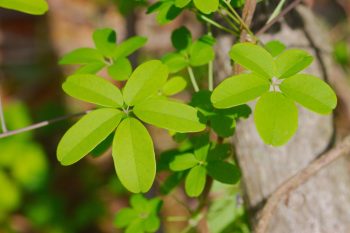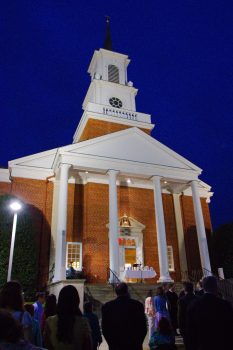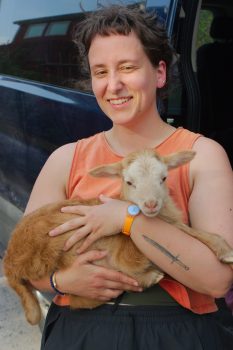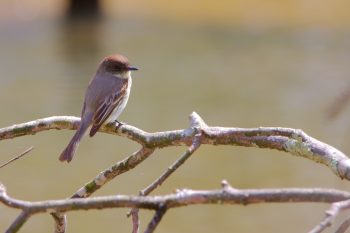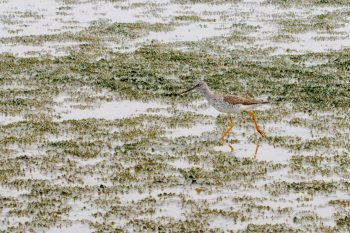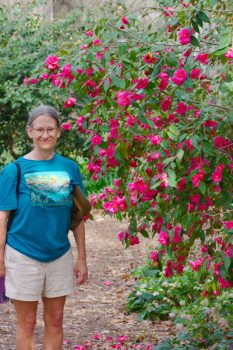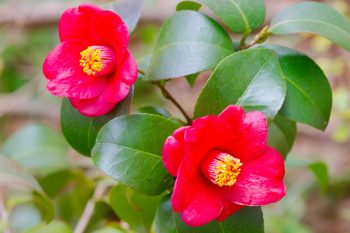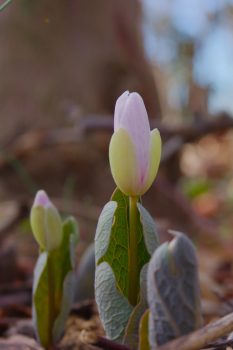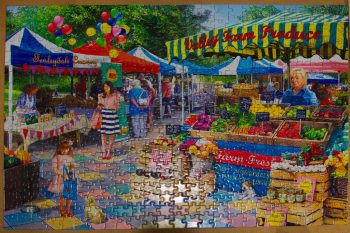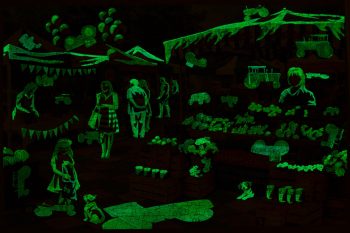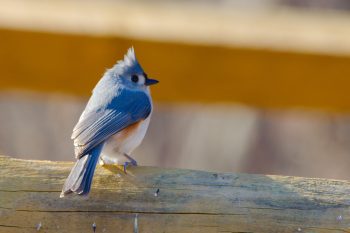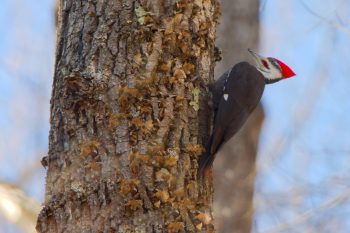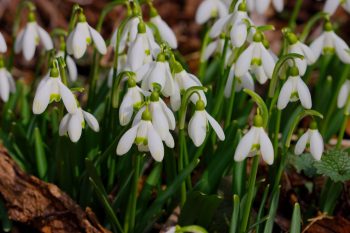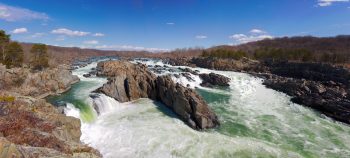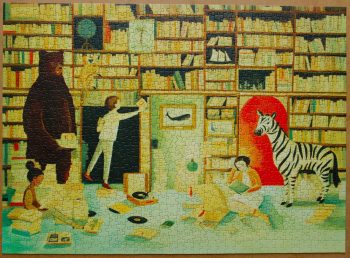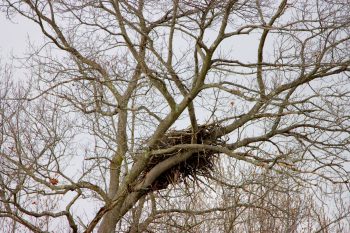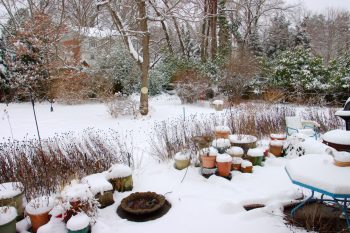Years ago my dad planted both three- and five-leaved akebia at the land in Pennsylvania. I haven’t found any of the three-leaved type but there is some five-leaved Akebia quinata, also known as chocolate vine. Although it is listed as a noxious weed in some states, and while it’s managed to survive without any care here, it hasn’t spread in a way that’s concerning, especially when compared to the hardy kiwi that’s nearby. I love the leaves, as shown here. It has interesting, purple flowers and one of the more unique fruits I’ve seen. From the Missouri Botanic Garden’s Plant Finder, “Flowers give way to sausage-shaped, violet fruit pods (to 4” long) which split open in fall to reveal small black seeds imbedded in a whitish pulp. The whitish pulp is edible.”
Akebia quinata
Easter Sunrise Service
Dorothy and I are big fans of Easter sunrise services. In particular, we have gone to the Fourth Presbyterian Church Easter sunrise service pretty regularly for quite a few years. I’ve been to a few others, including one at a little Moravian church in south central Virginia that was quite nice. Cathy isn’t quite as big a fan, liking the service well enough but not so fond of having to get up at 5:00 AM to get to the church by 6:00. Once we’re there, she enjoys it well enough. Some years it’s been quite cold. Last year, with an early Easter (March 31) it was in the low 40s. Two years ago is was right around freezing. Three years ago, however (April 17, 2022), it was very cold.
Between the sunrise service and the first ‘regular’ service we all went to the upper room for breakfast, which is a nice time to visit with folks that we don’t see often (since this isn’t our church). The 8:00 AM service is always nice, especially in terms of the music, singing familiar Easter hymns (except one where they unaccountably changed it up on us) and with an orchestra. The service ends with the choir and congregation singing George Frideric Handel’s Hallelujah Chorus, which after all these years I’m almost able to get through properly.
Dorothy and Kid Goat
Cathy, Dorothy, Jeff and I went out to Rocklands today. Among other things we had a nice, fairy long visit with Janis over a bottle of wine and a pizza. We also walked up to the road where Dorothy had done so much brush clearing a few years back. We also ran into Anna and her kids and we talked with them. Anna’s kids also had a kid, which Dorothy is holding in this photo.
We were there longer than we had expected but it was a beautiful day and nice to be out.
Eastern Phoebe (Sayornis phoebe)
Cathy and I went to Seneca Creek where Berryville Road passes right next to it. We saw a belted kingfisher (Megaceryle alcyon) on a tree leaning out over the water and I was able to get a few photos, although it was pretty far away. We walked upstream and enjoyed the bluebells (Mertensia virginica) that wrre pretty much in full bloom. Some of the flowers were brown, probably as a result of the recent freeze we had a week or so ago.
We heard quite a few birds, including wood thrush (Hylocichla mustelina) and northern waterthrush (Parkesia noveboracensis). We didn’t see either of those. A blue-gray gnatcatcher (Polioptila caerulea) kept showing up on Cathy’s Merlin screen but I didn’t expect to be able to see this little, elusive bird. We did, though, and I was able to get a photo or two.
Today’s photo is of an eastern phoebe (Sayornis phoebe) who sat on a branch over the creek and let me get fairly close.
Marsh Grass, Blackwater National Wildlife Refuge
We returned home from Delaware today. We decided that we’d stop at Blackwater National Wildlife Refuge, going first to the visitor center and then went to the short boardwalk at the end of Observation Access Road. The Marsh Edge Trail was closed because there is an active bald eagle’s nest near that trail. We could see the nest from the boardwalk but didn’t see any activity. We did see ospreys on their nests in a few different places and another eagle nest at the western end of the drive. This photo was taken from the boardwalk and I like the patterns of grass and water.
Greater Yellowlegs (Tringa melanoleuca)
Cathy and I visited friends in Delaware this weekend. We went to Prime Hook, a National Wildlife Refuge on Delaware Bay. The background of this photo makes it a little hard to see the bird at first, but otherwise, I like the picture. This is a greater yellowlegs (Tringa melanoleuca). They are differentiated from the lesser yellowlegs (T. flavipes) by their size (if seen side by side), by the Greater’s longer, thicker and slightly upturned bill. While we are in the northern most extent of their winter range, they migrate through on their way to the mid-latitudes of Canada for the summer.
Emberglow at Michaux
Cathy and I took off work an hour early and drove up to Gettysburg today. We met Dorothy on the Square where we picked up burgers from Blue & Gray (recommended) and took them to Gettysburg Recreation Park to eat. It was a beautiful, if cool, evening. After dinner, we walked to the Michaux Brewing Company for an evening of music (and a little beer) with Emberglow. We last saw Emberglow at Ploughman’s on January 18. Michaux has more space, which meant we were better able to see them, especially when Mo stepped up to the mic and they all sang together. Emberglow is, from left to right, Keisha, Mo, Jeff, and Julia. They have five more gigs on the calendar (that I know of): 06/06 at Pilger Ruh; 06/20 at Thirsty Farmer Brew; 07/25 back at Michaux; 08/23 at The Garryowen; and 09/12 at Reid’s Winery and Cider.
Cathy with ‘Red Candles’ Camellia
For the last few years we’ve gone to the U. S. National Arboretum during rose season, trying to catch some of the earlier, species roses. This year we decided to try our luck at getting there during the Camellia season, which for spring blooming Camellia japonica is early spring. Because that coincides with cherry blossoms, the Arboretum was quite busy. We drove past the cherry blossoms, though, and started in Fern Valley. There used to be a huge variety of daffodils planted there, but those are almost entirely gone now. It’s a little early for most things in Fern Valley but we did see some spreading Jacob’s-ladder (or Greek Valerian, Polemonium reptans), golden ragwort (or golden groundsel, Packera aurea), cutleaf toothwort (Cardamine concatenata), spring beauties (Claytonia virginica), bloodroot (Sanguinaria canadensis), and quite a few trout lilies (Erythronium americanum).
From there we moved on to the Asian collection, which is where the Camellias are grown. I did a pretty good job of recording the names of the flowers I photographed and picked a few that I might consider adding to our garden. The photo here is the only one I took of Cathy with the Camellias and it’s called ‘Red Candles’, a very nice, vigorously flowering C. japonica.
Camellia japonica ‘Hokkaido Red’
Of the camellias in our yard, this one is among the most successful. It’s a fairly slow growing shrub, so it will be a while before it’s really visible in it’s location behind the azaleas in front of our house. Nevertheless, from our front porch it’s quite visible and has a lot of flowers on it. Another called ‘April Rose’ that I planted at the same time, however, is barely holding on to life. I haven’t given up on it yet, but it isn’t encouraging. The oldest camellia I have, called ‘Pink Perfection’, is finally to the point where I’m not worried about it surviving. It’s almost five feet tall and doing well.
Sanguinaria canadensis (Bloodroot)
We had a load of things in the van to go to the dump today and thought we might also make a quick stop at the thrift store to drop some things off there. We decided, though, that we didn’t really have enough for the thrift store but we had left too early to go straight to church. So, we stopped for short visit to the Montgomery County Agricultural History Farm Park. There were things in bloom in the shade garden, which we always enjoy. These are bloodroot (Sanguinaria canadensis) buds and leaves coming up. It’s one of my favorite native plants and a wonderful sign of spring.
Other things blooming included the Pieris japonica (Japanese andromeda) and of course there were daffodils. The Eranthis hyemalis (winter aconite) was done blooming. In the larger demonstration garden there was a little activity but nothing anywhere near blooming yet. Once we have a few warm days, though, that will change.
Glow-In-The-Dark Puzzle
We’ve continued working on puzzles, doing those given to us by Donna, a family friend. They are mostly 500 piece puzzles and are fairly easy to put together but it’s something to do. We have a card table in our family room with a four foot square board on it. I added molding to the edge which reduces the number of pieces that get knocked onto the floor. It doesn’t prevent that completely and we finished one puzzle and found that a single piece was missing. We looked on the floor but didn’t find it. We left it there for a day or two and Cathy was on the floor stretching when she noticed the piece. I’m not sure how we missed it, but the rug we have seems to camouflage them very well.
While working on this puzzle we noticed that the surface of the pieces was a little rough. It wasn’t until we were done that we found out that it was a glow-in-the-dark puzzle. We put the boxes away while we’re working on them, to make them a little more challenging (and to avoid cheating). I set the camera up on a tripod and took pictures of it both with the lights on (the first image) and then with the lights off. The exposure was 30 seconds at f/4 at ISO 200.
Tufted Titmouse (Baeolophus bicolor)
As mentioned in the previous post, we went to Croyden Creek this afternoon. After our walk, on which we saw the woodpecker, we returned to the nature center, where we had parked. I took a few pictures of birds around the feeders there. That included a northern mockingbird (Mimus polyglottos), a few dark-eyed juncos (Junco hyemalis), and this tufted titmouse (Baeolophus bicolor). This photo makes him look more blue than gray, but either way, it’s a cute little bird that is hear year round and is often heard repeating Peter-Peter.
Pileated Woodpecker (Dryocopus pileatus)
We went to Croyden Creek this afternoon, and walked the loop to the east, following the creek down towards Rock Creek, then looping up to near Norbeck Road and back to the old Avery Road cut. About a third of the way around we heard and then saw this pileated woodpecker (Dryocopus pileatus) high on a dead tree. They certainly are a treat to see, with their red crest, as they dig insects out of trees and stumps. Their call and the very deliberate thumping of their beak against the wood is unmistakable.
Snow Drops (Galanthus nivalis)
Cathy and I took a walk at lunch time today, going about half way around the block that our office is on. There’s a cut through to the parking lot of my building from the back, which is how we got back. We walked through some of the empty lot next to my building but didn’t see much in the way of bird life. That building lot has been empty and waiting to be built on since before Dorothy was born (and before I worked there), so, a long time. In the current market, I don’t see that changing any time soon. On a lighter note, the snow drops (Galanthus nivalis) are blooming.
Great Falls, Virginia
A week ago we had temperatures under 20°F but today it was a lovely day and we really wanted to get out. We decided to go to Great Falls on the Virginia side of the river (not that the falls are in Virginia, but we were). After stopping at the three overlooks (at one of which this photo was taken) we walked on the River Trail as far as Sandy Landing, returning to the visitor center by another route. There were quite a few people out and everyone was enjoying the spring-like day. At one point we heard a noise we couldn’t identify, it turned out to be frogs, chirping or croaking in chorus.
Library Puzzle
Cathy brother Jim gave us this puzzle for ‘Second Christmas’ and we finished it yesterday. For a while we thought there was a piece missing but happily it turned up, having disguised itself on the rug under the table. This was a tricky puzzle, especially after we had finished the border and the red area behind the zebra, which was by far the easiest part. It’s also a puzzle where looking at the picture on the box would have made a big difference but of course we don’t do that.
Dot’s Birthday
We didn’t have a big party this year, but Cathy and I stopped over to see mom this evening, since today is her 94th birthday. She’s adjusted to her new living situation quite well and we’re very pleased with the support she’s getting there. Her apartment is small but comfortable and a good size for her. As you can see, we have one of her quilts hanging on the wall behind us.
Bald Eagle Nest
We walked to Lake Frank today and I took a few pictures of the eagle nest across the lake but we didn’t see either of the eagles. There is a tree near the southern end of the lake where we often see one of them perched so we walked towards that. It had been raining earlier in the day but when we left on our walk the sun was out. As we walked south, the wind picked up and the sky turned grey. About the time we got to where the eagle often sits (but we didn’t see it today) the rain started. We turned for home and were pretty wet by the time we got back. A half hour later the sun was out again. Ah, spring.
Snow
The last few years we haven’t really had much snow. I wouldn’t describe what we had the last couple days as a huge snowfall but comparatively it was a lot. This was out second snowfall of the year when we have gotten more than an inch, with about four inches on the ground this morning. It’s quite pretty and it wasn’t all that hard to clear the driveway or walk, so I didn’t mind it too much. Naturally mom called to tell me to hire a high school student to shovel so I wouldn’t have a heart attack. But actually, I enjoyed being out today. And it’s always nice being out in this when you know you can come back inside and get warm again when you’re done.
Mallards (Anas platyrhynchos)
Second Christmas, like all good things, must come to an end. After another visit to grandma, we drove Jim, Abba, and Hannah to the airport a little before midday today. Their flight got cancelled but fortunately they were able to get on another flight and got home without any real problem. Cathy, Dorothy, and I walked the perimeter of of Theodore Roosevelt Island after dropping the others off. There wasn’t a lot going on but I did like these two mallards (Anas platyrhynchos) sitting on a log near the mouth of the marsh at the south end of the island.

